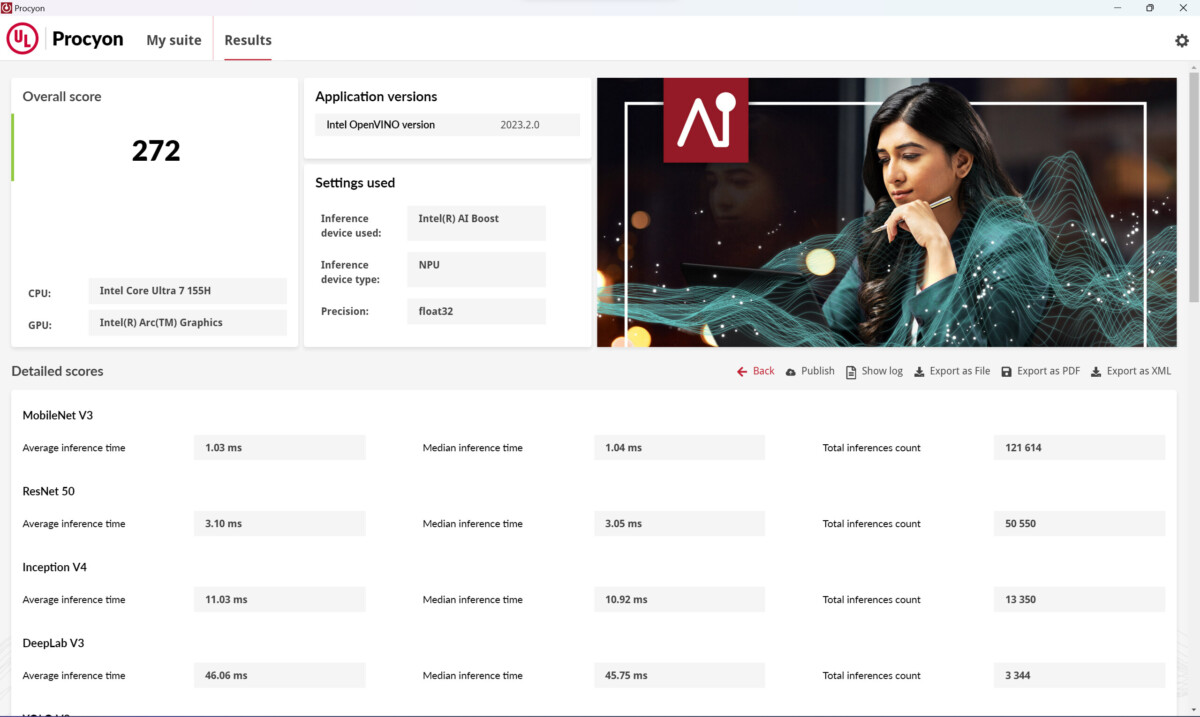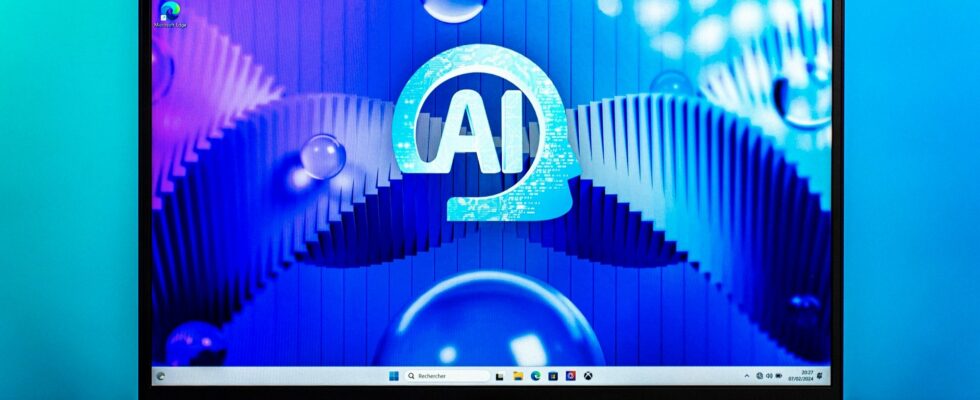If the name MSI is synonymous with PC video games, we must not forget that the Taiwanese manufacturer is involved in all aspects of computing. And yes: even ultrabooks, these PCs better known for their autonomy than their power. But with the release of the new Intel Ultra processors, capable of offering both power and autonomy, the MSI Prestige 16 expects to be good at both.
MSI Prestige 16 AI Studio B1V Technical sheet
| Model | MSI Prestige 16 AI Studio B1V |
|---|---|
| Dimensions | 358.4mm x 18.95mm |
| Definition | 2560 x 1600 pixels |
| Display technology | LCD |
| Touch screen | No |
| Processor (CPU) | Core Ultra 9 185H |
| Graphics chip (GPU) | NVIDIA GeForce RTX 4070 |
| RAM | 32 GB |
| Internal memory | 1024 GB |
| Operating system (OS) | Microsoft Windows 11 Pro |
| Weight | 1600 grams |
| Depth | 254.4mm |
Product sheet |
The machine is on loan from MSI for this test.
MSI Prestige 16 AI Studio B1V Design
Far away are the lines of a gamer when you hold the MSI Prestige 16. On the contrary, the chassis is rather sober, with a black dress and rectangular shapes with rounded corners which do not clash in the current IT space. Above all, we must remember the manufacturing quality, in particular its aluminum and magnesium alloy chassis certified MIL-STD-810H for increased resistance to everyday hassles.
Source: Chloé Pertuis for Frandroid

Source: Chloé Pertuis for Frandroid
What we really remember about this computer and its physical appearance is the great importance given to cooling. On the left side of the device, we can observe a large exhaust grille, two at the rear, while the bottom of the device also has a large rectangle. The rubber feet of the device used to raise it are also quite high and very rigid, and the shell is very easy to open thanks to the use of simple Phillips screws.
Keyboard and touchpad
Here we are faced with a full-size keyboard which also integrates a full-size numeric keypad, a good thing whereas many other manufacturers tend to reduce the axis to fit the numbers. The switches used are very well made with a good rebound, soft, but lively, which guarantees precise typing, but not very audible.

The touchpad is superbly wide with a really comfortable click. The only criticism: it is still placed very far to the left of the chassis, and we would have much preferred to find it in the center.
The computer also includes a fingerprint reader on its power button, as is tradition, which is added to facial recognition through Windows Hello. The last being the simplest to use, we will tend to favor it, but this double presence gives a reassuring security aspect to the machine.
Connections
Good point for the MSI Prestige 16, which is rarely found on ultrabooks of its ilk: most of the connectivity is placed at the back of the device. MSI’s gaming DNA is felt here. We still find an Ethernet port on the right, and above all a full-format SD card reader which is a pleasure to see.

Source: Chloé Pertuis for Frandroid

Source: Chloé Pertuis for Frandroid

Source: Chloé Pertuis for Frandroid
At the back therefore, we are entitled to everything we want to see on this type of PC: An HDMI 2.1 port, a USB A 3.2 Gen 2 port, a USB-C Thunderbolt 4 port and a USB-C 3.2 Gen 2. Both support USB Power Delivery, power source for the configuration.
If we would have liked to find a small additional USB A port to round things off, it would be in bad faith not to cite this MSI Prestige 16 as one of the PCs with the best connectivity of its generation. Everything is there.
Webcam

On the webcam side, we find a simple 1080p sensor. However, its processing is very successful, with a good white balance and good color processing. However, we still find a very noticeable noise, which means that the camera remains mainly dedicated to videoconferencing. We also note that despite the AI leaning of this computer, the background blur integrated into the Zenbook 14 OLED is not found here. However, other software will allow you to take advantage of it, such as XSplit.
MSI Prestige 16 AI Studio B1V Screen
The MSI Prestige 16 is equipped with an IPS LCD panel supporting a definition of 2560 x 1600 pixels, i.e. a 16:10 ratio, with a maximum refresh rate of 60 Hz. This panel is not touchscreen.
Under our probe and with the DisplayCal software, we find coverage of 147% of the sRGB space for 104% of the DCI-P3 space. Maximum brightness here is measured at 372 cd/m², which is quite light for an ultrabook, with an excellent contrast ratio of 1951:1. The average color temperature recorded is 6512K; simply perfect.

The average Delta E00 measured is 2.43 with a maximum deviation of 8.16 on blue tones. It is therefore not the best calibrated panel on the market, but it remains below the 3 expected for the majority of the experience. There is no doubt that experienced creatives will know how to calibrate it a little better: the potential is there in any case.
On the other hand, the lack of a higher refresh rate is a real disappointment. In 2024, it’s hard to stop being choosy by only taking advantage of 60 Hz, with all PC categories integrating at least 90 Hz for some time now.
MSI Prestige 16 AI Studio B1V Software
In addition to an expected Windows 11, we can especially count on MSI Center to manage the computer on a daily basis. Underrated software even though it offers all the features we expect as a bonus with interesting modules to add to the experience, such as Smart Priority which allows fine control of access to PC resources.

We will especially remember this MSI Center for its multiple use scenarios, two of which are particularly important here: Intelligent Auto, and Ambient Silent AI. The first uses artificial intelligence to give the right resources to the right software at the right time, and is refined for your use. The second, more surprising, but not without interest, analyzes the noise made by your computer in real time to adapt its use and keep it silent at all times.

Two scenarios that make AI truly relevant to the user here. We will simply regret the pre-installation of Norton Antivirus on the machine: less worse than McAfee, but still annoying.
MSI Prestige 16 AI Studio B1V Performance
The MSI Prestige 16 from 2024 therefore benefits from this famous Intel Core Ultra 7 155H in our test configuration. The latest Intel SoC with 16 cores — 6 performance, 8 efficient and 2 ultra-efficient — for 22 threads that can turbo up to 4.8 GHz. Here it is associated with 32 GB of LPDDR5 RAM at 6400 MHz, and benefits from the new Intel Arc integrated GPUs whose performance rivals the Z1 Extreme. The computer also benefits from an Intel Killer Wi-Fi card compatible with Wi-FI 7 and Bluetooth 5.4, as well as 1 TB of PCIe Gen 4.0 storage.
Benchmarks
We said it in the introduction: MSI has chosen here to focus on power more than autonomy. We can see it under Cinebench R23, where the scores of 14,219 points in multi core and 1761 points in single core make it much more powerful than the Asus Zenbook 14 OLED benefiting from the same configuration. The Ryzen 7 7840U is finally beaten, while waiting for the new 8000 generation. These scores correspond to 827 points in multi core and 104 points in single core under Cinebench 2024.

This is not the same observation regarding the acceleration of artificial intelligence calculations. The integrated NPU achieved a score of 272 points under OpenVINO, the model dedicated to Intel, for 157 points under Windows ML accelerated by the Intel Arc GPU. Similar scores, or even slightly below for Windows ML, to the Asus Zenbook 14 OLED. The opportunity to see that manufacturers can also influence this data when it comes to calibrating their PCs for 2024 on the Intel Core Ultra platform. Here, MSI seems to have remained conservative.

On the storage side, the 1 TB provided in PCIe 4.0 gives us some of the best performance on the market. We find 6545 MB/s in sequential reading for 4875 MB/s in sequential writing, which clearly proves to us that we are on a modern SSD. Random read/write rates are also very satisfactory; enough to hold many uses.
Cooling and noise
We said it: here, the focus is on power. The 2024 MSI Prestige 16 is therefore much less hesitant to heat up its chassis, which provides numerous air intake and exhaust points. Most of it goes to the side of the device, which reaches 52°C at full synthetic load for a lower chassis at 55°C. These are the temperatures most expected from gaming PCs, but the ultrabook has the merit of not being heard more than necessary. Above all, we see proof of the multiple capabilities of the Intel Core Ultra 7 here, which we will also find on more gamer-oriented PCs during the year.

MSI Prestige 16 AI Studio B1V Autonomy
The 2024 MSI Prestige 16 is not economical when it comes to its autonomy. We indeed find a very large 99.99 Wh battery on this one, which we are more used to seeing in much larger PCs such as gaming PCs. Here again, MSI’s DNA is visible, even if the Prestige 16 counterbalances this with a thickness that is a little marked than the average ultrabook at 1.7cm.
In terms of autonomy, we find use in office automation, brightness set at 50%, between 11 and 12 hours of varied use. A good score, but which can disappoint compared to the Zenbook 14 OLED which reaches 15 hours of autonomy without flinching, and the MacBooks running Apple M which also go beyond. This is where the focus on power is felt, although battery life above 10 hours remains excellent. The competition is tough !
MSI Prestige 16 AI Studio B1V Price and availability
The MSI Prestige 16 from 2024 is already available in France. Our test configuration is sold there at the recommended price of 1799.95 euros.
Where to buy
MSI Prestige 16 AI Studio B1V at the best price?
